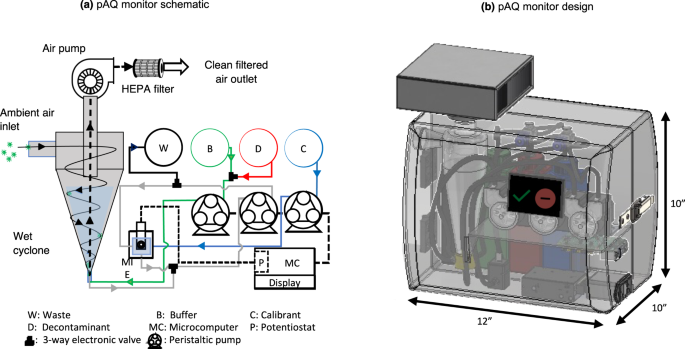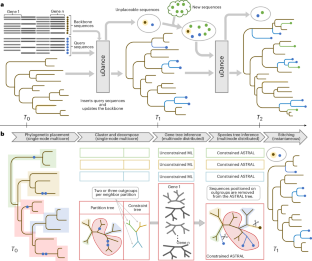2023-07-31 ワシントン大学セントルイス校
◆3Dプリンターを使用して製造されたこのデバイスは、呼気中のエアロゾルをバイオセンサーに集める仕組みで動作します。現在臨床研究が進行中であり、デバイスの有効性が検証されています。
<関連情報>
- https://source.wustl.edu/2023/07/scientists-develop-breath-test-that-rapidly-detects-covid-19-virus/
- https://pubs.acs.org/doi/10.1021/acssensors.3c00512
- https://www.nature.com/articles/s41467-023-39419-z
医療現場で呼気中のSARS-CoV-2エアロゾルを迅速直接検出 Rapid Direct Detection of SARS-CoV-2 Aerosols in Exhaled Breath at the Point of Care
Dishit P. Ghumra, Nishit Shetty, Kevin R. McBrearty, Joseph V. Puthussery, Benjamin J. Sumlin, Woodrow D. Gardiner, Brookelyn M. Doherty, Jordan P. Magrecki, David L. Brody, Thomas J. Esparza, Jane A. O’Halloran, Rachel M. Presti, Traci L. Bricker, Adrianus C. M. Boon, Carla M. Yuede, John R. Cirrito, and Rajan K. Chakrabarty
ACS Sensors Published:July 27, 2023
DOI:https://doi.org/10.1021/acssensors.3c00512
Abstract

Airborne transmission via virus-laden aerosols is a dominant route for the transmission of respiratory diseases, including severe acute respiratory syndrome coronavirus 2 (SARS-CoV-2). Direct, non-invasive screening of respiratory virus aerosols in patients has been a long-standing technical challenge. Here, we introduce a point-of-care testing platform that directly detects SARS-CoV-2 aerosols in as little as two exhaled breaths of patients and provides results in under 60 s. It integrates a hand-held breath aerosol collector and a llama-derived, SARS-CoV-2 spike-protein specific nanobody bound to an ultrasensitive micro-immunoelectrode biosensor, which detects the oxidation of tyrosine amino acids present in SARS-CoV-2 viral particles. Laboratory and clinical trial results were within 20% of those obtained using standard testing methods. Importantly, the electrochemical biosensor directly detects the virus itself, as opposed to a surrogate or signature of the virus, and is sensitive to as little as 10 viral particles in a sample. Our platform holds the potential to be adapted for multiplexed detection of different respiratory viruses. It provides a rapid and non-invasive alternative to conventional viral diagnostics.
SARS-CoV-2エアロゾルのリアルタイム環境サーベイランス Real-time environmental surveillance of SARS-CoV-2 aerosols
Joseph V. Puthussery,Dishit P. Ghumra,Kevin R. McBrearty,Brookelyn M. Doherty,Benjamin J. Sumlin,Amirhossein Sarabandi,Anushka Garg Mandal,Nishit J. Shetty,Woodrow D. Gardiner,Jordan P. Magrecki,David L. Brody,Thomas J. Esparza,Traci L. Bricker,Adrianus C. M. Boon,Carla M. Yuede,John R. Cirrito & Rajan K. Chakrabarty
Nature Communications Published:10 July 2023
DOI:https://doi.org/10.1038/s41467-023-39419-z

Abstract
Real-time surveillance of airborne SARS-CoV-2 virus is a technological gap that has eluded the scientific community since the beginning of the COVID-19 pandemic. Offline air sampling techniques for SARS-CoV-2 detection suffer from longer turnaround times and require skilled labor. Here, we present a proof-of-concept pathogen Air Quality (pAQ) monitor for real-time (5 min time resolution) direct detection of SARS-CoV-2 aerosols. The system synergistically integrates a high flow (~1000 lpm) wet cyclone air sampler and a nanobody-based ultrasensitive micro-immunoelectrode biosensor. The wet cyclone showed comparable or better virus sampling performance than commercially available samplers. Laboratory experiments demonstrate a device sensitivity of 77–83% and a limit of detection of 7-35 viral RNA copies/m3 of air. Our pAQ monitor is suited for point-of-need surveillance of SARS-CoV-2 variants in indoor environments and can be adapted for multiplexed detection of other respiratory pathogens of interest. Widespread adoption of such technology could assist public health officials with implementing rapid disease control measures.


